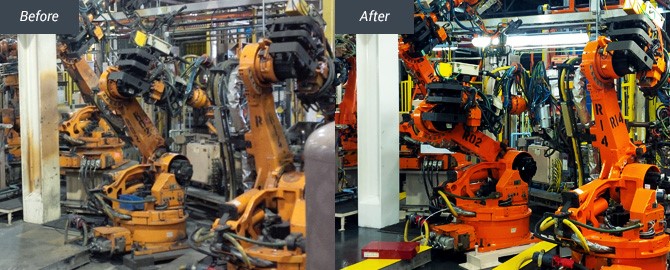Preventing Corrosion
Corrosion is a process whereby materials, usually metal, deteriorate as a result of a reaction with their surrounding environment. For corrosion to take place, three components must be present in the environment – Oxygen, Water and a source of ions. The greater the concentration of these components, the more rapid the corrosion reaction will be. There are two broad classifications of corrosion: general and localized corrosion. General corrosion results in a uniform loss of material over the entire surface where localized corrosion occurs at discrete areas on the surface of metals.

Maintenance Painting
Allow Harrison Muir to provide a quote for maintenance painting at your facility. Our team can handle complicated projects, coordinating with other trades, project managers and owners. Our sophisticated approach will minimize downtime, boost productivity, increasing profits.
Protective Coatings
The intended service life of a corrosion protection system represents the engineered economic value of that system by providing protection for an asset. The selection of a particular corrosion protection system is typically a function of economic, operational, environmental and safety issues. Coatings are used in many different ways to serve many purposes. They may protect the substrate from a corrosive environment. They may prevent contamination of a material by the containment. Coatings have many different uses only one of which is to beautify.
Floor Coatings
Want a high performance floor coating? Want an anti-slip surface? Need it done in a short period of time? Harrison Muir can provide the complete package. Surface preparation by shot-blasting, repair of damaged or cracks in concrete, application of epoxy and or polyurethane coatings will protect your concrete floor from harsh working conditions.
Plural Component Spray
Plural component airless spraying is a method of coating that mixes multiple component coatings at the point of application by use of multi-piston pumps; synchronized to operate together at a controlled ratio and flow. The pumps ensure both coating components are delivered at the right pressure and ratio. The coating components are pumped through the paint lines, and then mixed at the spray gun tip. The process also involves separate heat circulating pumps which heat components of the coating to a specified temperature resulting in similar viscosities. Some advantages of plural component spray systems are the ability to spray apply very thick, solvent free materials without thinning, spray materials with very short pot lives and the accurate and automatic mixing of materials. Harrison Muir has plural component spray technicians on staff to aid in complex coating scenarios.
Chemical Resistant Coatings
Some environments can be detrimental to coatings. These coatings must resist breakdown from the chemicals to which it is exposed. Harrison Muir has a great deal of experience installing chemical resistant coating systems in both interior and exterior applications.
Tank Linings
The term “lining” is an industry standard for describing a coating that is normally in immersion service. Linings can used to protect the surface they’re applied to, and can be designed to protect the cargo contained within the coating. Application of linings can be quite overwhelming, from an engineering or an applicators stand point. Often the process for the installation of a tank lining involves careful selection of the coating for the service conditions and engineering controls, confined space safety measures and a step by step application process. Quality control is very important and often requires holiday detection by a spark test for quality assurance prior to return to service. Let Harrison Muir employ decades of knowledge and experience, taking all complications out of your project.
Fiberglass Reinforced Linings
A Fiberglass Reinforced Linings is the process of inserting a glass or synthetic fiber into a curing resin. This system is designed to be more resistant to movement, abrasion and impact over a standard lining system.
Metalizing
Spray metalizing (thermal spraying) is a process of coating metal onto the substrate. Two metal wires (zinc or aluminum) are inserted into the torch so they contact each other at the nozzle. Placing an electrical load on the wires causes the tips to melt when they touch. Compressed air then strips the molten metal off the wires and transports it to the surface.


